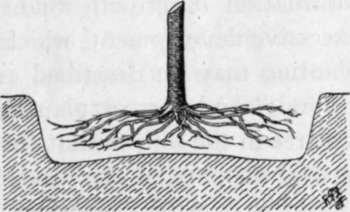Chapter XV. Fruit Tree Planting
Description
This section is from the book "School Gardening", by W. Francis Rankine. Also available from Amazon: School Gardening.
Chapter XV. Fruit Tree Planting
CORRECT planting is the first step towards success in fruit culture. There are many people who regard planting as an absurdly easy operation, yet it must be stated in justification that few of these have any idea of the function of roots and rootlets. Fruit tree planting is quite an easy matter if it is followed out in the proper manner, and in fact it is much easier-and more profitable-to plant a fruit tree correctly than it is to place it carelessly in the ground. We are reminded from our junior days that there is a right and a wrong procedure for every operation, yet probably, in ordinary gardening, there is no more emphatic illustration of this truth than in the planting of a fruit tree.
In the first place, it is necessary to select the station for the tree, and we will suppose that thorough cultivation has been carried out. Dig a circular hole about eighteen inches deep and three feet to four feet in diameter. Now take the tree and examine the roots, and if these have been bruised or abrased trim off the damaged portions with a sharp knife. Place the tree in the hole and arrange the roots carefully so that they are in a natural position, viz., radiating from the stem and always having a slight downward tendency. Attention to root position is the most important matter. Any able-bodied man can dig the hole but only the able-minded gardener can see that the roots are arranged so that they are able to develop. By this we do not mean that the operation can be performed by the privileged few, but that it may be done by everyone who cares to take the trouble. When the planter is convinced that the roots are properly arranged, the next step is to replace the soil. This process demands much care, and it must be accomplished gradually. If is useless to fill in the hole at once, for the soil must be placed firmly around the roots. This can only be done by gently pressing the soil about them, and under no consideration must the soil be rammed down, for this only results in bruising the roots.

Fig. 55 fruit tree planting.
The slightly convex base of the station prevents water from accumulating round the roots.
In the case of the smaller trees such as the Currant and Gooseberry, the same process is repeated, although smaller holes are necessary-the same care in the arrangement of the roots and the filling in of the soil should be observed. Raspberries should be treated in the same way. Often the fault of the novice lies in loose planting, so that it is quite easy to uproot the tree after finishing, and this is invariably followed by coarse, unfruitful shoots. This is undesirable, and can never happen if the above instructions are explicitly followed out.
Bad planting may be traced to one of two causes, carelessness or ignorance, and the former is quite unpardonable. The results may be the death of the tree, retardation of growth that takes years to correct, or excessive development, which entails root pruning. Bad planting may be described as " sticking the tree in the ground," and correct planting as the careful placing of the tree in the soil, so that the roots, which are the fundamental support of the tree, have every opportunity of extending. After planting, the trees should be attached to the stakes. These should always be placed in the station as soon as it is prepared for the reception of the roots, and prior to the actual planting, for the driving of the sharply pointed stake through the root system cannot be considered as conducive to healthiness of the root fibres.
Strawberries, although these are not fruit trees, demand especial care in planting, and much depends on the proper arrangement of the root system when they are placed in the ground. Often they are placed in the soil in such a manner that the roots are matted together, and weak plants are the result. The same care that is taken of large trees is necessary here, the roots being spread out and the plant sunk to such a depth that the crown is just above ground. Then press the soil round the roots so that the plant is firmly supported.
The planting of a fruit tree or a strawberry plant may appear a troublesome process in reference to the detail that must be observed, yet, " what is worth doing is worth doing well," and it is far better to throw the trees and plants on the rubbish heap than to place them in the ground in a slovenly way. Nothing of real good can result from such treatment, for if the trees and plants are started badly, the most expert gardener will experience the greatest difficulty in bringing them back to the path of righteousness. The roots are vital organs, and they are ever ready to carry on their functions correctly and persistently, and no blame can be attached to the nurseryman who supplied the tree or to the soil-be it well cultivated-if the planting is improperly performed. The only remedy for this is replanting, and if a tree has been " stuck " in the ground, the only recourse is to lift it and replant it with due observance of the advice laid down in this chapter.
Continue to:
- prev: Chapter XIV. Suitable Fruits
- Table of Contents
- next: Chapter XVI. Small Fruit. Currants, Gooseberries
